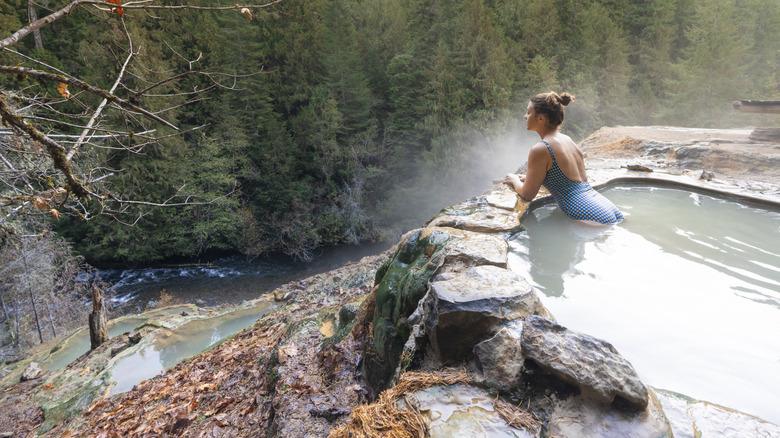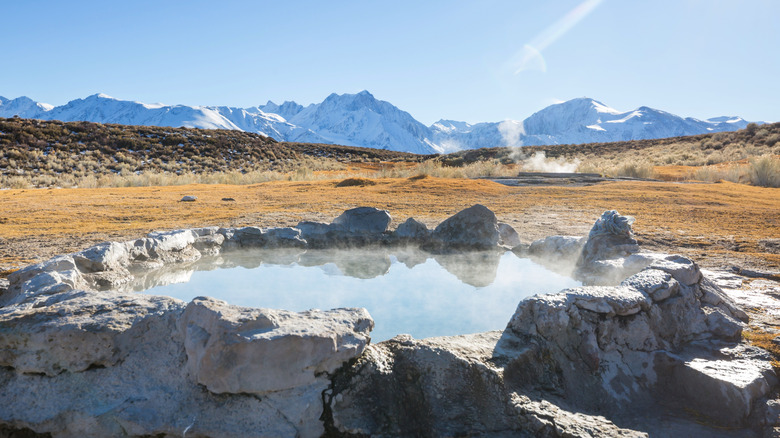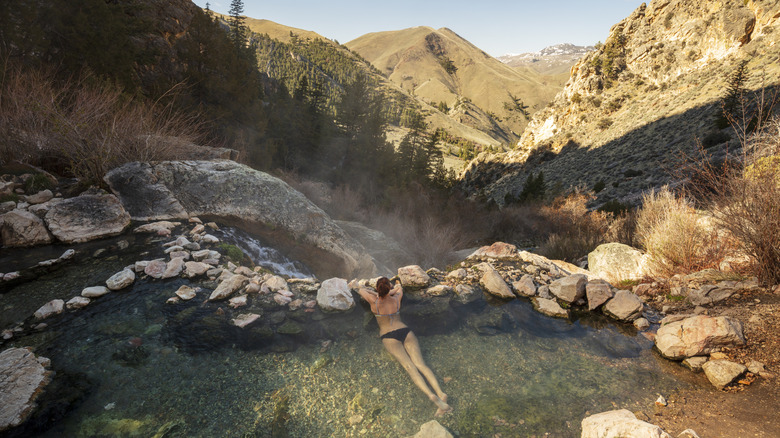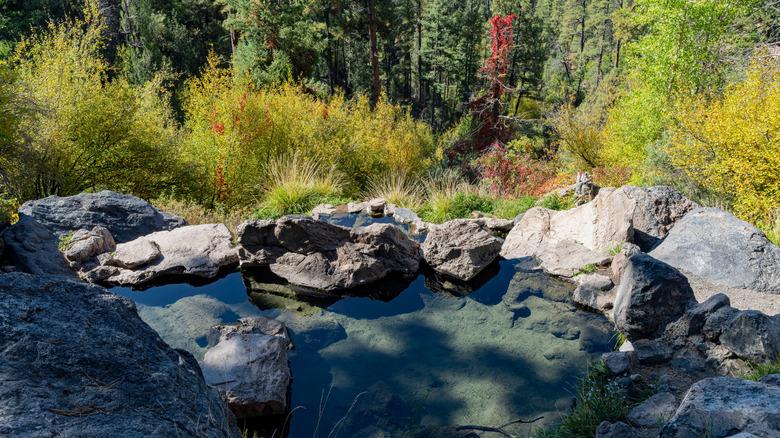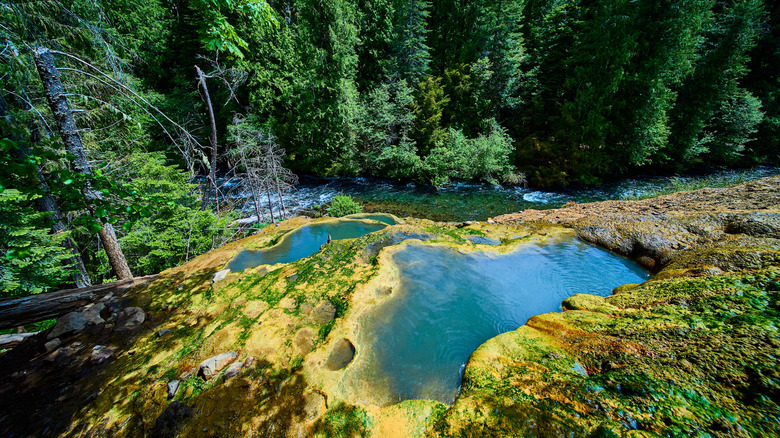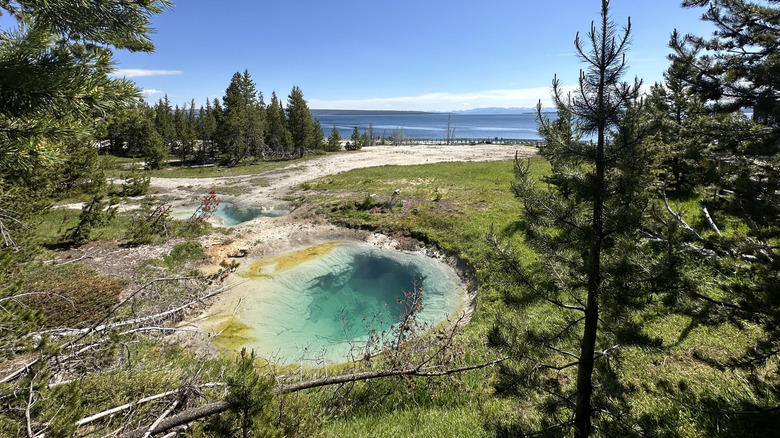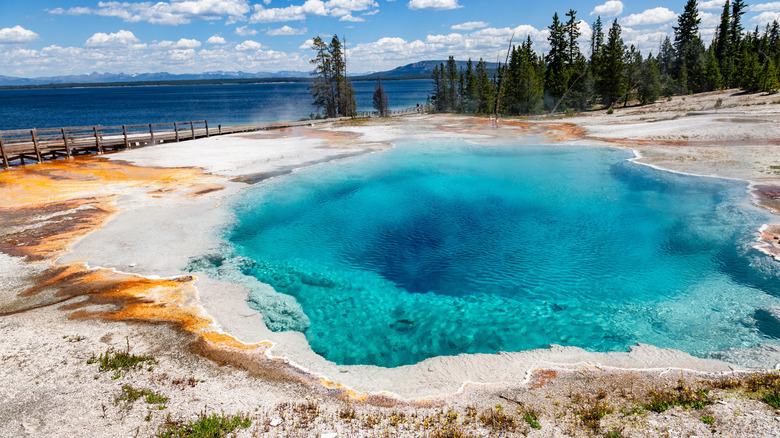The Best States To See Hot Springs (Other Than Colorado), According To Research
Colorado may be the poster child of American hot springs, but it's not the only state with geothermal springs bubbling to its surface. In fact, the U.S. is home to more than 1,600 hot springs scattered across mountains, deserts, canyons, and alpine wildernesses. Each has been shaped by millions of years of subterranean pressure from deep within the earth's fiery core, producing hot springs, mineral-rich geysers, and mud pots. Over half of the country's documented thermal springs can be found in just three western states: California, Nevada, and Idaho, each with more than 150 localities. Wyoming follows with more than 100 such sites, with Oregon, Utah, Montana, New Mexico, and Colorado completing the lineup.
If you look at the map published by Hot Springs of America, most geysers and thermal springs are clustered along the West Coast and Pacific Northwest, owing to the region's geological makeup. Historically, hot springs served as sacred healing grounds for Native American communities for thousands of years. Today, however, more than half those springs have been developed for public use — turned into spa resorts and wellness retreats, or tapped as sources for water and irrigation (especially on federally managed land).
Given that, the best states for seeing hot springs aren't necessarily the ones with the most geothermal activity, but those that protect their wilder pools. Both fortunately and unfortunately, those tend to be springs that don't make it onto maps. The methodology behind this list draws on multiple online rankings and personal recommendations from travelers on Reddit, combined with geographic data showing where the country's hot springs are most concentrated — all to highlight the best states to see hot springs across the U.S.
California
Behind Colorado, California might as well be considered a geothermal mecca. Sitting along the Pacific Ring of Fire – a zone responsible for much of the world's earthquakes and volcanic activity — California's hot springs owe their existence to the same tectonic forces that shape its dramatic mountains and valleys. There, groundwater seeps deep underground, heating as it passes molten rock, and then rises back to the surface in mineral-rich pools.
The highest concentration of geothermal hot springs is in eastern California, particularly around Desert Hot Springs and Palm Springs — hence the names. Given the state's size and geologic variety, its springs range from remote, undeveloped natural pools to commercial wellness retreats. For example, the Spring Resort and Spa in Desert Hot Springs offers a high-end, adult-only wellness retreat built around mineral-rich waters. Further north, Indian Springs Resort and Spa in Calistoga – one of Napa Valley's oldest springs, open since 1861 – takes a more restorative approach. Guests come for its signature mud baths, combining spring water and volcanic ash, as well as an Olympic-sized pool fed by geysers.
Another standout is The Inn at Benton Hot Springs, a desert hideaway near Mammoth Lakes. This property features nine outdoor tubs and pools, each made from different materials, and guests can often control their own soak temperature. Alongside the cozy bed and breakfast, the inn also offers camping sites that include private spring-fed tubs. For something more urban, Beverly Hot Springs in Los Angeles is the city's only natural hot spring spa. Discovered in the early 1920s during an oil survey, it features a hot pool, cold plunge, and spa facilities — proof that you don't need to leave the city to find some geothermal serenity.
Idaho
Idaho is home to more than 300 hot springs – more than any other state in the country — with over 30 developed into retreats. Conveniently, many lie along the Thousand Springs Scenic Byway, a 68-mile-long route that runs parallel to the interstate and is dotted with waterfalls and hot springs. On Tripadvisor, a visitor from the Netherlands described it aptly: "This is a really nice drive and the name is not exaggerated. Lots of Springs/waterfalls to be seen while driving."
Among Idaho's most popular springs is the rugged Burgdorf Hot Springs near McCall, prized for its sense of isolation. Listed on the National Register of Historic Places, this rustic retreat offers a rare look into Idaho's frontier past, once serving as an old Western mining town. Today, visitors are encouraged to switch off their phones and embrace the stillness without distractions. Accommodations are basic: There is no electricity, running water, or bedding provided. The springs are accessible by car in summer; in winter, they are reachable only by snowmobile. Winter is the least crowded time to visit and arguably the most rewarding. It sounds like a hassle to get to, but once there, you'll be treated to steaming 113-degree pools surrounded by hiking trails and conifer trees.
One of Idaho's most unique springs is Boat Box Hot Springs, and it's pretty much as the name describes. Fresh spring water is channeled into what can only be described as an old mining-era contraption, which looks like a well-used hot tub. The water can be scorching, but thanks to the Salmon River rushing past, visitors can easily regulate the temperature by adding cold water.
New Mexico
New Mexico's hot springs are a lucky byproduct of its complex geology, shaped by volcanic fields, fault zones, and thermal aquifers beneath the earth's surface. These springs have been cherished for centuries, first by Native Americans and later by Spanish explorers, who regarded them as natural healing "Fountains of Youth."
The state is best known for Ojo Caliente, a luxurious retreat between Santa Fe and Taos that holds the distinction of being one of America's oldest natural health resorts. Unlike many springs, its mineral healing water is sulfur-free, but rich in iron, lithia, and soda — a winning cocktail thought to improve digestion, mood, and overall immunity. Opened in 1868, Ojo Caliente offers a wide range of amenities, including yoga, farm-to-table dining, mud baths, and accommodations ranging from rustic campsites to a full-service luxury lodge.
A 90-minute drive to the south, across the Santa Fe National Forest, lies Jemez Spring, formerly known as Giggling Hot Springs. The waters originate from a source deep beneath the Valles Caldera National Preserve, just a few miles north of the town. This historic site features four mineral pools that sit between a comfortable 98 and 105 degrees Fahrenheit. Over 100 years old, Jemez Hot Springs retains a long history — long used by Indigenous people and later developed with bathhouses — and remains a popular destination for both locals and tourists. For a more secluded hot spring experience, Spence Hot Springs in the Jemez Mountains offers two pools sitting at 95 degrees Fahrenheit, connected by a trickling waterfall. Access requires a short hike, meaning it is usually less crowded than other springs.
Oregon
According to a U.S. Geological Survey report, most of Oregon's thermal hot springs are located in the southeastern and central parts of the state. Oregon's geothermal activity is powered by two main sources: Volcanic energy and the movement of tectonic plates. Sitting in these thermal pools, it's fascinating trying to conceptualize the journey the water has taken from deep volcanic chambers up to the surface.
Of the nearly 170 documented hot springs in Oregon, most are concentrated in the Basin and Range Province, stretching from the Cascade forests to the high desert regions. As elsewhere in the country, the springs here range from undeveloped and remote to commercial resorts and rustic destinations, some accessible only by hiking.
For Portland locals, Breitenbush Hot Springs, considered one of the best hot spring hotels in America, is a standout destination. Just a two-hour drive from the city, it's been transformed into a wellness retreat with a strict alcohol and device-free policy. Visitors can choose from a variety of accommodations, including the historic 100-year-old lodge, mushroom-shaped yurts, glamping tents, and even a bring-your-own campsite. The property was partially saved by firefighters during a massive wildfire in 2020, and remains a wonderful spot to experience Oregon's geothermal wonders.
Montana
If any U.S. state is synonymous with geothermal activity, it's Montana. It's home to Old Faithful, the most famous and consistent boiling water geyser in the country, located in the heart of Yellowstone National Park. This is also where you'll find the Grand Prismatic Spring, the third-largest hot spring in the world, known for its rainbow colors and an impressive depth exceeding ten stories. While these iconic features aren't suitable for a relaxing soak, Montana has plenty of other accessible hot springs, mostly following the angles of the state's mountains, rivers, and valleys.
One of the most famous is Bozeman Hot Springs. Located just 45 minutes from Big Sky Resort, it's the perfect pitstop after a day on the slopes. Today, the resort features a dozen pools of varying temperatures, some outdoors and others enclosed in a glass building to retain heat. It also offers amenities such as a fitness center, saunas, and a campground for those who wish to spend the night.
For those visiting Yellowstone National Park, Yellowstone Hot Springs is well worth the detour. Although technically not within park borders, these hot springs are located just ten minutes north of the national park. You can rent a cabin or bring your own RV into the property, making it a good option for travelers looking to diversify their activities. History fans should consider visiting the Chico Hot Springs, a beautifully preserved rustic resort that dates to the early 1900s. The property includes a historic lodge, modern cabins, and even glamping tents, all with full access to the springs. Day visitors are welcome, too, and there is a poolside restaurant and full spa services,ensuring a rejuvenating experience for everyone.
Methodology
Determining the best states to see hot springs in the U.S. isn't as simple as it sounds. With more than a thousand known geothermal springs scattered across the country, each differs in natural beauty, water quality, facilities, and accessibility. To compile this list, we started by identifying the locations of most of the nation's geothermal springs. While we looked beyond simply choosing the states with the highest concentrations, those regions naturally offered more variety and therefore ranked higher overall. Our primary source was the Thermal Springs of the United States study published by the U.S. Geological Survey. Using this data, we highlighted the states that provide the best opportunities to experience hot springs — not just those with a handful of remote or difficult-to-reach sites.
To find the standout locations within these states, we drew from a combination of sources, including Hot Springs of America, multiple travel blogs, and online publications like Hot Springs of America. We also factored in firsthand traveler recommendations from Reddit and Tripadvisor, cross-referencing springs that appeared repeatedly across multiple sources. We noted distinctions between developed spa resorts and wild, natural pools, basing our assessments on publicly shared information rather than personal experience.
Of course, this methodology is not without limitations. There is no perfect way to compare every hot spring, or to measure subjective qualities like beauty or atmosphere. The five states featured here were chosen for their blend of accessibility, diversity of experiences, visitor amenities, and geological richness.
